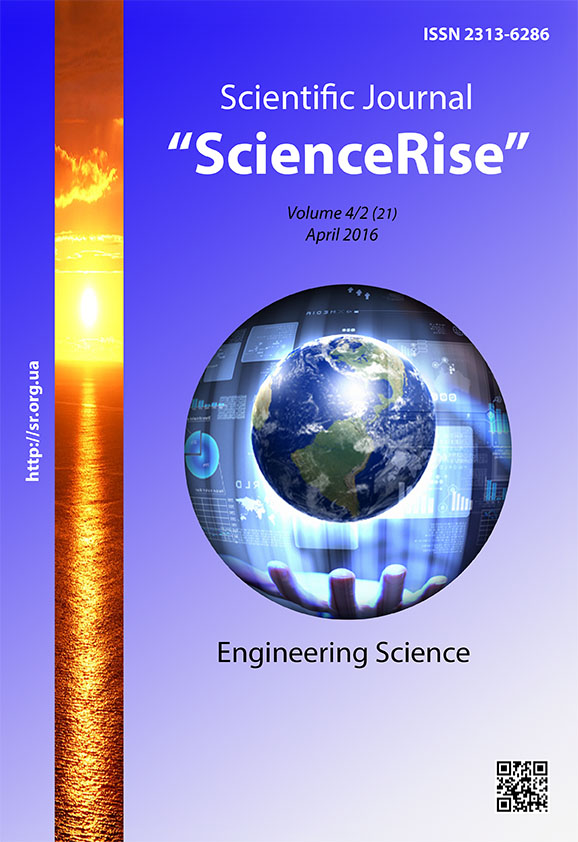The model of adjacency region of the "crack" defect" in a digital image
DOI:
https://doi.org/10.15587/2313-8416.2016.65947Keywords:
monitoring, crack, image, adjacency, region, set, matrix, display, limit, circuitAbstract
The process of the emergence and spread of the crack defect is accompanied by the appearance of related defects and damages, which are located at a slight distance from the channel of the crack, and form the defect region of the monitoring object with it. In this article the results of researches are given for determining the area of adjacency of the crack defect in the digital images. Properties of display to construct adjacency region are defined and investigated and algorithms for its building in the digital images are described
References
Pratt, W. (1982). Digital processing of image. Vol. 1, Vol. 2. Moscow: Mir, 312, 480.
Pavlidis, T. (1986). Algorithms for computer graphics and image processing. Moscow: Radio and communication, 400.
Gonzalez, R., Woods, R. (2005). Digital image processing. Moscow: Technosphere, 616.
Duda, R., Hart, P. (1976). Pattern recognition and scene analysis. Moscow: Mir, 509.
Shapiro, L. G., Stockman, G. C. (2001). Computer Vision. N. J.: Prentice Hall, Upper Saddle River, 608.
Simankov, V. S., Lutsenko, E. V. (1999). Adaptive control of complex systems based on the theory of pattern recognition. Krasnodar: Tech. University Cuban. state Indus. University press, 318.
Gorda, E. (2010). Identification of defect type "crack" in the optical range. The Mountain. building, road and reclamation machines. Kyiv: KNUBA, 74, 89–93.
Gorda, E. (2014). Simulation metrics in the space of a digital image defect type "crack". Managing the development of complex systems. Kyiv: KNUBA, 17, 112–120.
Oxtoby, J. (1977). Measure and category. Moscow: Peace, 158.
Aleksandrov, P. S. (1977). Introduction to set theory and General topology. Moscow: Nauka, 368.
Borisovich, Yu., Bliznakov, N., Izrailevich, Y., Fomenko, T. (1995). Introduction to topology. Moscow: Nauka, Fizmatlit, 416.
Halmos, P. (1953). Measure theory. Moscow: Foreign literature publishing house, 282.
Ryshkov, S. S., Maltsev, A. A. (2002). Discrete geometry and geometry of numbers. Moscow: Nauka, 335.
Bobenko, A. I., Suris, Y. B. (2010). Discrete differential geometry. Integrable structure. Moscow: Publishing house: "SIC "Regular and chaotic dynamics", Institute of computer science," 488.
Lukin, A. (2007). Introduction to digital signal processing (mathematical foundations). Laboratory computer graphics and multimedia, Moscow state University. Moscow, 54.
Fu, K. (1977). Structural methods in pattern recognition. Moscow: Mir, 320.
Downloads
Published
Issue
Section
License
Copyright (c) 2016 Олена Володимирівна Горда, Олексій Олександрович Пузько

This work is licensed under a Creative Commons Attribution 4.0 International License.
Our journal abides by the Creative Commons CC BY copyright rights and permissions for open access journals.
Authors, who are published in this journal, agree to the following conditions:
1. The authors reserve the right to authorship of the work and pass the first publication right of this work to the journal under the terms of a Creative Commons CC BY, which allows others to freely distribute the published research with the obligatory reference to the authors of the original work and the first publication of the work in this journal.
2. The authors have the right to conclude separate supplement agreements that relate to non-exclusive work distribution in the form in which it has been published by the journal (for example, to upload the work to the online storage of the journal or publish it as part of a monograph), provided that the reference to the first publication of the work in this journal is included.

